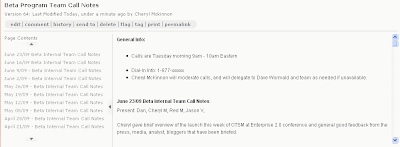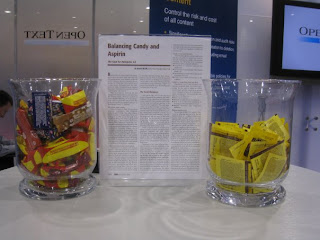
A whirlwind week in Boston as we launched
Open Text Social Media to the premier gathering of Enterprise 2.0 thinkers, vendors and practitioners. The downside? I didn't attend nearly as many of the sessions as I had circled in the guide. The upside? Fantastic one-on-one meetings all week with customers, prospects, partners, press, analysts, bloggers. We chatted in meeting rooms, at the Starbucks, in the pub and of course, those comfy couches in the Open Text Lounge.
Still a lot of angst in the E2.0 world about making it real. How do we measure, how do we justify. SHOULD we measure? SHOULD we justify? How to get management buy-in, how to get community engagement.
Well, this week my colleagues & I tried to make it real. Most of the people who stopped by our lounge for a discussion about our new product saw something a little different. No virtual images. No dummy demo servers. No "what you COULD do.."
We spoke about our own personal day-in-the-life: as active production users of our own dogfood. (I know, I know...some colleagues hate that term. Champagne.. coffee... whatever). And we showed sample people, process and content scenarios based on the reality of how we do things.
Sometimes it is the simple story that delivers the lightbulb moment to people who don't quite see the value yet.
For me, it's my story of
"The No E-mail Beta". **
In November we announced our 2.0 plans at Open Text Content World, and started recruiting customers interested in beta program participation. From November '08 to early '09, we talked with customers, learned about their potential use cases, their requirements, and narrowed down the list of participants who were keen and committed. The beta participants have been an incredibly rich source of feedback, ideas, and generous with honest and open comments on likes and dislikes.
In December, we kicked off a weekly status call for all of our internal people: development, services, product management and marketing, customer relationship managers, spanning at least 4 countries and likely 8+ cities.
Over the 7 months, about 40 people have been in and out of the weekly calls, depending on their roles and phase of the project. Once a week, a core set of this team got on the phone. And as people join the call, I open up our beta community workspace, go to the wiki for weekly status calls, click 'edit' and go.

While on the phone, the roll call is done, the old business reviewed, action items knocked off, new items added, we recap the status of all the customer beta communities, wrap up with a open discussion on issues or interesting topics. And when we're done, I click "save", and whammo. Instant meeting notes, organized consistently from week to week, categorized by the date and call number, immediately ready for anyone who missed the call, and optionally pushed out as a notification to those who chose to subscribe to updates.
Simple, fast, efficient.
7 months = 28 weekly calls so far, 2.5 action item updates per week x (40 people x 25% on core team) = ~700 emails not sent
Cool, but not the light bulb moment. That moment came a month ago when we got an intern from the university for a summer work term. How to get him up to speed rapidly and accurately to get him productive on Day 1? Easy. Sent 1 URL to the status call wiki, he read from bottom to top and knew what was going on and who the key people were. I actually cannot even imagine how long that would have taken if we would have relied on e-mail communication.

But it was not just the technology that made this work. It was the people - the people who committed to working this way. The core team who led by example. Who posted action items in the community (never underestimate the power of peer pressure to get things done). By delegating the call chair duties by posting a shout-out to the community when travel or vacation made it impossible for me to dial-in. By wanting to all be able to walk the talk in front of our colleagues, partners and customers.
2.0 technology made this easy, it but didn't 'cause' the success. The community workspace and wiki was a tool that made sense for the task - bridging a diverse, distributed global team focused on a shared objective. I haven't even personally met everyone on the team yet. But I know their smiling faces, what they can contribute, and what I've learned from them. My
Social Workplace in action.
** OK, the 'almost' no-email beta program. Full disclosure: we used email with colleagues who had a specific role for a narrow portion of the program. Ie, getting the corporate legal OK on any agreements. And for customer communication before they went live. And my comment to my colleagues who subscribed to automated email notifications, well, that was your own choice. Some good E2Conf recap blog posts so far - (watch
the #e2conf twitter stream as more pop up over next few days):
Sameer Patel @ PretzellogicRon Miller @ Fierce Content Management 1 of 2 (argh. I bad hair day, but was fun chat with Ron in the ultimate conference social workplace, the hotel lounge)Ron Miller @ Fierce Content Management 2 of 2 "Neatest Technology at Enterprise 2.0" And yep... we're there ;-)Doug Cornelius @ Compliance Building He called out some great reality checks as 2.0 comes into business and faces compliance and governance issues of the real worldWhat I Learned... @ Mashup PatternsSocial Amber - It's about the people...E2Conf Blogger Janetti Chon "It's a Wrap"




























